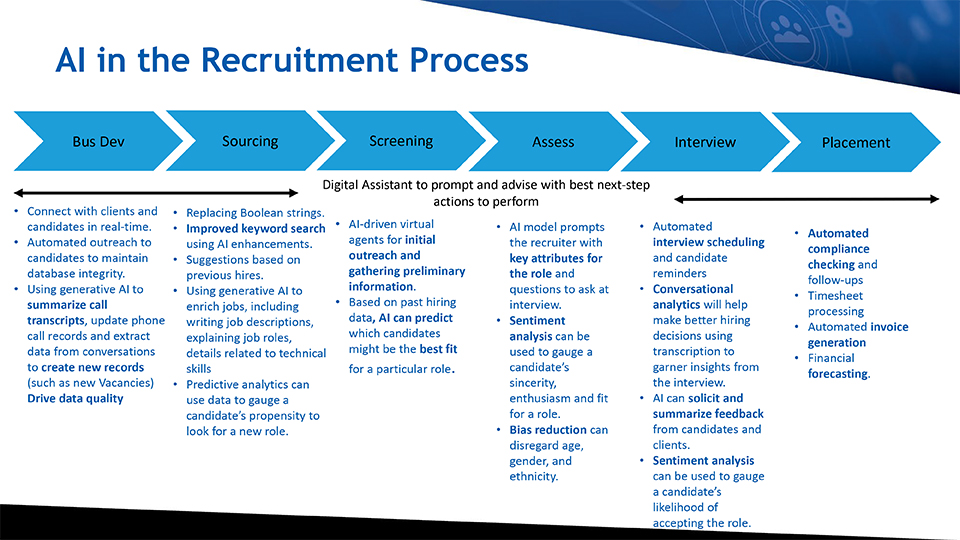
The Future is Now-AI in Recruiting
AI technologies are developing and evolving rapidly. They have the potential to change – even disrupt – almost every aspect of our lives and our work.
Properly harnessed, AI will support the work of staffing professionals in a number of ways. Salespeople and recruiters will be more effective and productive. Staffing companies can reduce costs and operate more efficiently. Also, AI can help businesses use the data at their disposal intelligently …. in a way that is safe and compliant.
Throughout its team of professionals, Mercury has over 175 years of combined experience in recruitment, and over 140 years of consulting experience in recruitment software and technology. Dave Cox, Account Manager, and Jerome Guerard, Vice President of Sales with Mercury, recently presented to TechServe Alliance members about the benefits of AI in recruitment, and the considerations in its implementation.
AI in the recruitment process
During the presentation, Cox outlined how AI technologies can be employed at every stage of the recruiting cycle.
Business development
- AI helps your team connect with clients and candidates in real time, and at the right time to maximize results.
- Automate your outreach to candidates so that data integrity is maintained.
- Use generative AI technologies – like OpenAI’s ChatGPT, Google’s Bard, and Copilot, from Microsoft – to enrich existing data and create new data as well. Summarize transcripts of calls, and update call records automatically. You can even extract data from conversations to create new records, like new vacancies.
Sourcing
- AI allows sourcing staff to use plain, intuitive language instead of Boolean strings, improving the results of keyword searches.
- Use data from previous hires to generate suggestions for new candidate sources.
- Use generative AI to help write job descriptions, and to explain roles and technical requirements to recruiting staff and candidates.
- Predictive analytics applied to candidate communication can even help gauge their level of interest in a new role.
Screening
- Use AI virtual agents (i.e., chatbots) for outreach, and for collecting basic information at the initial stages.
- Using historical hiring data, AI can help predict which candidates might be the best fit for a given position.
Assess
- AI can help provide the recruiter with key attributes required for a given role, and targeted questions to ask in interviews.
- Sentiment analysis can help gauge a candidate’s fit, and their true level of interest in the role.
- AI is not subject to human bias, and can perform assessments without regard for gender, age, ethnicity, and other discriminatory factors.
Interview
- Save time and effort with automated scheduling and interview reminders.
- Conversational analytics can be applied to interview transcripts to produce additional insights from the interview.
- Automation tools can solicit and summarize feedback from candidates and clients.
- Sentiment analysis can help predict a candidate’s likelihood of accepting an offer, prompting additional probing by the recruiter, and reducing the chance of a last-minute rejection.
Placement
- AI tools can save time – and help support compliance – by automating checks and follow-ups, timesheet processing, invoice generation, revenue forecasting, and more.
Post-placement
- Automate the process of checking in on candidates to ensure the placement is going well.
- Trigger notifications to recruiters at regular intervals when candidate contracts are expiring, to increase the likelihood of redeployment.
All of these possibilities – allowing for greater efficiency and productivity for sales and recruiting staff – are enabled by a digital assistant which prompts and advises the best next actions for your team.
Just like any other major business decision, though, the decision to integrate AI technologies into your process requires forethought and planning.
Considerations
It always pays to begin with the end in mind. Cox stresses that the first step is to identify the problems you want to solve with AI. How effective is your prospecting, client mapping, and outreach process? How easy, or difficult, is it for your team to track clients and candidates? Is your customer experience as good as it could be? On the delivery side of your business, how efficient is internal search for your recruiters?
“Think: ‘What is effective?,’ not just efficient. What’s efficient for you might not be efficient for other people. Everybody is different, and every business model is different, but you should be looking at how you can make existing staff more productive and effective, as well as get newer people up to speed more quickly.”
Data integrity
AI is an incredibly powerful tool, but – as with any program or algorithm – it is only as good as the data it has to work with. “You can’t build a house without solid foundations,” says Cox, “and for AI, data integrity is the foundation.”
He offers three tips for ensuring your data is as clean as it can be:
- Eliminate duplicate data. Getting rid of redundant records is the most important first step in making sure your systems have useful data.
- Consolidate your data sources. Think: ‘single source of truth.’ Data that is siloed, stored in numerous external repositories, means that your processes will be manual and time-consuming.
- Check your CRM compliance. How are resumes parsed? Are skills tagged accurately? Often, Cox says, this can be fixed by simply making some data fields mandatory.
Digital transformation
As was covered in depth in a previous webinar and blog, digital transformation is more than just a simple change in processes. Cox points out that it can often involve a systems change, which may in turn require implementing new operating processes.
“One of the components in the AI journey,” Guerard says, “is to define what your North Star is for your tech stack in 2024 and beyond. To look at all of this and say, ‘Okay, what do our humans do really well, and what are tasks that we can offboard through automation and AI? There’s a lot that can be done, but you need the architecture to do it. There’s a lot of opportunity for organizations to evolve and transform if they have the right foundation, the right data architecture.”
As a Microsoft partner, Mercury sees tremendous value in the integration of their solutions with the Microsoft 365 environment. Their staffing-specific solution – tying into the sales CRM, the ATS, candidate engagement and business intelligence systems – eliminates the ‘Frankenstack’ syndrome of multiple disparate systems. Cox also notes that this integration means greater data security.
Apart from the specific technology decision, the key, Cox says, is to realize that the integration of AI is greater than a simple software change. In fact, the first consideration of all is where you want software to end and the human to begin.
“Recruitment is a human interaction business. It always has been. That’s what makes it great, right? The relationships with your customers, your candidates, we don’t want to stop that. So, when you start thinking about what you would like AI to do for your business, you also need to think about where human interaction should come in.”
Naturally, any change in process causes changes for the people putting those processes into action. For the changes to stick, and to result in the outcomes you want, user adoption is key. That requires good change management.
Change management
Change is difficult, even for the people leading that change.
“It sometimes happens that people want to use AI to make this process easier, but they don’t actually want to change the process that they’ve currently got,” Cox says. “Tech should enable a new process that’s easier to adopt. It shouldn’t be the other way around, because then all you’re doing in most cases is trying to fit a square peg into a round hole.”
Change is also difficult for the people being asked to adopt that change. From your staff’s perspective, any change – no matter how worthwhile – can create anxiety and resistance. The fix? Communication. Cox and Guerard have seen implementations handled well, and the common thread begins with the phrase: ‘What’s in it for me?’
- Ensure that your team understands why the change is necessary, but even more importantly, how they will benefit. Keep driving home the way the change will improve their work and make them more productive and successful.
- Be honest, though, about the limitations and the outcomes they can realistically expect from the change. Setting expectations too high risks ending up with staff feeling let down and disappointed.
- Involve your staff in the change process early on. While it is natural to immediately think of seeking input from your experienced recruiters and salespeople, Cox also advises engaging junior staff in the process. “Remember, what’s sufficient for the experienced, top-performing person might not be best for the new person, and vice versa.”
- Seek this feedback and input prior to any new systems going into production, and make sure to follow up afterwards as well, three to four months after the implementation.
- Throughout the process, provide extra hands-on training, working with your staff through using generative AI in aspects of their process, and guiding them through a more efficient workflow.
In an ideal world, adopting the necessary technology and process changes would be a truly collaborative process. The world isn’t perfect, however, and change leaders should be prepared to be directive when it’s needed.
“Henry Ford said, ‘If I asked people what would make their transportation better, they would’ve said faster horses.’ Instead,” Guerard says, “Ford streamlined the production of cars. The same holds true here. Being more prescriptive in the workflow, and the tools and technology that they have at their disposal, is going to be critical.”
Are you ready for the AI future?
The way AI stands to change the way staffing companies work is sweeping.
“AI is revolutionary,” says Cox. “If it’s done right, it won’t just change the way your recruiters work, or the way your salespeople work. It can change the way that your organization works.” Are you ready for that change?
The information here – and more – was covered in a webinar. If you missed the live event, don’t worry! It was recorded, and you can view that recording here. Also, if you’re attending the TechServe Alliance Executive Summit, Mercury will be presenting in several of the program events. Join us and learn more about the future for AI in staffing.

